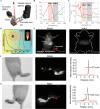The biological applications of near-infrared optical nanomaterials in atherosclerosis
- PMID: 39135099
- PMCID: PMC11320980
- DOI: 10.1186/s12951-024-02703-1
The biological applications of near-infrared optical nanomaterials in atherosclerosis
Abstract
Purpose of review: Atherosclerosis, a highly pathogenic and lethal disease, is difficult to locate accurately via conventional imaging because of its scattered and deep lesions. However, second near-infrared (NIR-II) nanomaterials show great application potential in the tracing of atherosclerotic plaques due to their excellent penetration and angiographic capabilities.
Recent findings: With the development of nanotechnology, among many nanomaterials available for the visual diagnosis and treatment of cardiovascular diseases, optical nanomaterials provide strong support for various biomedical applications because of their advantages, such as noninvasive, nondestructive and molecular component imaging. Among optical nanomaterials of different wavelengths, NIR-II-range (900 ~ 1700 nm) nanomaterials have been gradually applied in the visual diagnosis and treatment of atherosclerosis and other vascular diseases because of their deep biological tissue penetration and limited background interference. This review explored in detail the prospects and challenges of the biological imaging and clinical application of NIR-II nanomaterials in treating atherosclerosis.
Keywords: Atherosclerosis; Cardiovascular disease; Macrophage polarization; NIR-II nanoparticle; NIRF.
© 2024. The Author(s).
Conflict of interest statement
The authors declare no competing interests.
Figures






Similar articles
-
NIR-II upconversion nanomaterials for biomedical applications.Nanoscale. 2025 Feb 6;17(6):2985-3002. doi: 10.1039/d4nr04445b. Nanoscale. 2025. PMID: 39717956 Review.
-
Recent progress in development and applications of second near-infrared (NIR-II) nanoprobes.Arch Pharm Res. 2021 Feb;44(2):165-181. doi: 10.1007/s12272-021-01313-x. Epub 2021 Feb 4. Arch Pharm Res. 2021. PMID: 33538959 Review.
-
Intravascular Fluorescence Molecular Imaging of Atherosclerosis.Methods Mol Biol. 2022;2419:853-872. doi: 10.1007/978-1-0716-1924-7_52. Methods Mol Biol. 2022. PMID: 35238006 Free PMC article.
-
Near-Infrared II Fluorescence Imaging and Image-Guided siRNA Therapy of Atherosclerosis.J Med Chem. 2024 Jul 25;67(14):12428-12438. doi: 10.1021/acs.jmedchem.4c01208. Epub 2024 Jul 12. J Med Chem. 2024. PMID: 38996002
-
Modulation of Near-Infrared Afterglow Luminescence in Inorganic Nanomaterials for Biological Applications.Adv Mater. 2025 Apr;37(16):e2419349. doi: 10.1002/adma.202419349. Epub 2025 Mar 10. Adv Mater. 2025. PMID: 40062832 Review.
References
-
- Organization GWH. World health statistics 2022: monitoring health for the SDGs, sustainable development goals. Geneva: World Health Organization; 2022.
-
- Shen L, Li H, Chen W, Su Y, Yu J, Chen M, Shu G, Qiao E, Guo X, Xu M, et al. Integrated application of transcriptome and metabolomics reveals potential therapeutic targets for the polarization of atherosclerotic macrophages. Biochim Biophys Acta Mol Basis Dis. 2022;1868: 166550. 10.1016/j.bbadis.2022.166550. 10.1016/j.bbadis.2022.166550 - DOI - PubMed
Publication types
MeSH terms
Grants and funding
- 2023M741498/China Postdoctoral Science Foundation
- LSSY24H020006/Natural Science Foundation of Zhejiang Province
- LSSY24H020006/Natural Science Foundation of Zhejiang Province
- 2024KY560/Medical Science and Technology Project of Zhejiang Province
- 2022ZDYF12/Key Research and Development Program of Lishui
LinkOut - more resources
Full Text Sources
Medical
Research Materials
Miscellaneous

